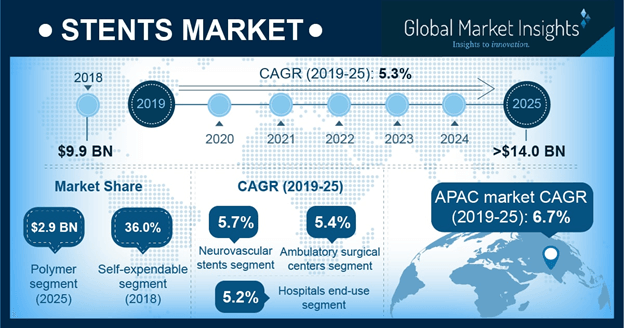APAC stent market to generate modest returns by 2025
Publisher : Fractovia | Published Date : July 2019Request Sample
Growing prevalence and morbidity of coronary heart diseases across developed nations will bolster stent market growth. A stent is a mesh-like tube which is placed in an artery or duct to help open and restore the flow of bodily fluids in a particular area. It helps relieve blockages and treat narrow or weakened arteries.
U.S. Stent Market, By Type, 2018 & 2025 (USD Million)

It also helps in preventing aneurysms in brain as well as open up other passageways in the body, such as lung airways, bile ducts, urinary tubes and leg arteries. Stringent regulatory norms and standards will help end-users gain high quality and durable stent portfolios. For instance, the ISO standards set for endovascular devices and vascular stents provides safety regulations related to design attributes, design evaluation, materials, packaging, and manufacturing.
Emergence of new stent technologies will expand stent market size. In 2019, device maker Acandis received the CE Mark for its Aperio hybrid stent retriever, designed specifically for fast arterial flow restoration and efficient clot retention in ischemic stroke patients.
Coronary stent segment has gained significant market share, on account of increasing cases of cardiovascular diseases worldwide. According to American Heart Association, cardiovascular diseases (CVD) accounted for around 17.9 million deaths in 2015 and is expected to grow over 23.6 million by 2030. Coronary artery disease (CAD) is the most common type of CVD that reduces blood flow to the heart due to buildup of plaque in the arteries. Stenting is a common way to treat CAD.
A stent is usually placed inside a coronary artery following balloon angioplasty which prevents re-closing of re-closing. In certain patients, stents also reduce the re-narrowing of arteries that sometimes occurs after procedures that use catheters. Studies suggest that patients with angioplasty and stents recover faster compared to patients undergoing coronary artery bypass surgery (CABG).
Technological advancements in stent have also led to increased application of stents in cardiovascular procedure. Furthermore, a rise in geriatric population has increased the demand for stents, thereby stimulating stent market size.
Based on technology, drug eluting stent segment has gained immense traction over recent years. Drug eluting stents (DES) can help prevent plaque buildup, allow good blood flow to the heart, and relieve possible chest pain. They also lower chances of potential heart attack or stroke.
DES is coated with time-release medicine that is gradually released into the blood vessel to prevent arteries from becoming re-narrowed. Most patients recover within a few days following drug-eluting stents insertion, further allowing to get back to daily schedule faster, stimulating product demand.
Rapid technological advancements have led to the development of improved DESs, which have consistently improved product efficacy and safety, offered long-term outcomes and significant reduced stent thrombosis. Latest stents technologies, including those with polymer-free, bioresorbable polymers, and fully bioresorbable scaffolds, are currently in early stages of development. Such advancements are certain to open up new growth opportunities in the industry over the coming years.
Increased application in hospitals, surgical centers and clinics will drive stent market size. Hospitals account for the highest market share due to increased demand for stents primarily to treat patients with cardiovascular diseases. Surgical centers will also record substantial demand on account of rising preference for ambulatory surgical centers in developed and developing economies.
Based on regional outlook, APAC stent market will amass modest proceeds over upcoming years. The region has witnessed a substantial increase in number of heart patients lately. Especially in India, over 55 million people were reported to be affected by CVD in 2016 and the number is growing exponentially, further posing huge social and economic concerns in the country.
To offer affordable stent treatments to an increasing number of heart patients, the Government of India announced lowering prices on cardiac stents, reducing angioplasty operation costs in tier 1 and metro corporate chains and private hospitals by up to 18%.
Moreover, in 2019, a new study led by public healthcare institutes found that imposing a price cap on coronary stents has helped a large number of patients from lower-income groups to undergo heart procedures, reportedly rising number of surgeries by 43% following recent price slash. With such supportive government initiatives, the APAC stent market will witness substantial growth prospects over the coming years.
Stent market is growing rapidly in both developed as well as developing economies on account of numerous technological advancements and increasing cases of cardiovascular disorders. Supportive government policies and increasing geriatric population will drive market size across developing nations. Rising demand for drug eluting stents and advancements in existing technologies will offer increased growth opportunities in the near future. Global Market Insights, Inc. estimates stent market size to exceed USD 16 billion by 2025.